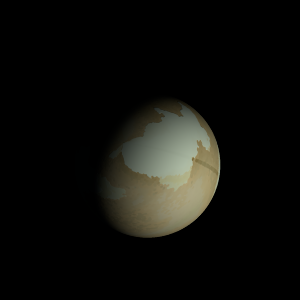|
|
Space Astro
|
Info for exoplanet "Asyao-hyuan"
| Scientific (actual) data |
|---|
| Name | Kepler-760 c |
| Planet status | Confirmed |
| Radius | 0.132 |
| Orbital period | 2.46697 |
| Discovered | 2016 |
| Updated | 2021-02-05 |
| Tconj | 2455190 |
| Publication | Announced on a website |
| Detection type | Primary Transit |
| Alternate names | 2MASS J19102237+4410459 c, K01069.02, KIC 8222813 c, KOI-1069 c, KOI-1069.02, WISE J191022.36+441045.9 c |
| Star name | Kepler-760 |
| Right ascension | 287.59° |
| Declination | 44.18° |
| Mag j | 13.707 |
| Mag h | 13.301 |
| Mag k | 13.239 |
| Star distance | 782 |
| Star metallicity | 0.08 |
| Star mass | 0.89 |
| Star radius | 0.85 |
| Star age | 4.57 |
| Star temperature | 5322 |
| Star alternate names | 2MASS J19102237+4410459, KIC 8222813, KOI-1069, WISE J191022.36+441045.9 |
| Wikipedia article | Kepler-760 c |
Back
| |
| Fictional info (?) |
|---|
| Suggested name | Asyao-hyuan |
| Planet type | Cold planet |
| As seen from Kepler-760, in a frame of reference that rotates with the orbital motion, it appears to rotate only once every two years. |
| Estimated population | 1200000000 |
| Atmosphere | Oxygen | 95% |
| Methane | 4.5% |
| Carbon dioxide | 0.013% |
| Water | 0.0074% |
| Atmospheric pressure | 0.08 bar |
 |
| No known satellites |
| Google search for Asyao-hyuan |
|
Website by Joachim Michaelis
|
|
|
|